Instructions for growing melons in Siberia in the open field for beginner gardeners
Melon fruits are amazingly tasty and healthy. In addition to vitamins, they contain a lot of fiber, pectins, potassium, magnesium, phosphorus, silicon and organic acids. Jams and marmalade, preserves and marmalades are made from sweet aromatic pulp, candied fruits are made. The greatest health benefits come from fresh melon.
More and more gardeners throughout Russia are planting this crop on their plots. Growing melons outdoors in Siberia is not easy because it is a southern plant. But a smart choice varieties, site preparation and proper planting care ensure a good harvest of sweet fruits even in the harsh Siberian climate.
The content of the article
Melon cultivation in a Siberian climate
Melons are cultivated in Siberia both in the greenhouse and in the open field. An important condition for the development of a plant is an average daily air temperature of at least + 15 ° C.
The fruits ripen about 3 months after the first shoots. The critical period is from the moment of sowing to the first 3 leaves. If on these days the temperature does not drop below + 25 ° C during the day, and below + 10 ° C at night, the pumpkins grow quickly and ripen.
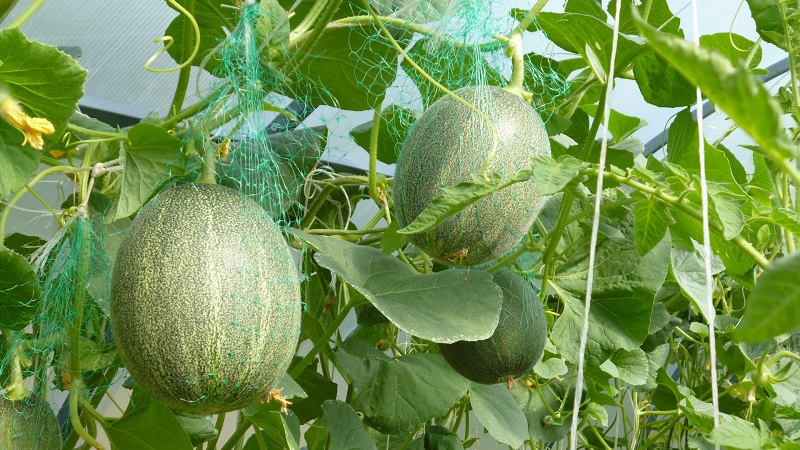
Weather
The heat-loving melon is traditionally cultivated in the south. In Siberia, this crop began to be grown recently, after the creation of new early-maturing varieties and hybrids.
In the south of the region, the culture grows well - sunny days in summer are enough for the fruit to ripen. A significant drawback of such a climate is its unpredictability. Dry and hot days give way to cold and rainy days. In the first half of June, there are often frosts and even snow. All these features are important to take into account before growing melons in Siberia.
Suitable varieties
The key to successfully growing a crop in unusual climatic conditions is the right choice of variety. In Siberia, melon in the open field is cultivated only through seedlings, giving preference to zoned and cold-resistant varieties.
Important! When choosing a variety, they are guided by the average number of warm summer days (no frost). This period is counted from the date of the last spring frosts and ends with the date of the first autumn frosts. Fruit ripening time, indicated on the seed package should be slightly shorter than the range.
The harsh climate is unstable, in such conditions it is not easy to accurately determine the frost-free period. Therefore, when growing melons, they are guided by the average temperature indicators of recent years.
Good results are obtained by the cultivation of early maturing varieties and hybrids. Most popular: Dream of Sybarite, Altai, Muscat white, Titovka, Caramel, Cappuccino, Lyubushka, Early 133.
Seed and soil preparation
To grow strong and healthy melon bushes, seeds and soil are pre-treated.
Seed preparation
The seeds of the hybrid are not prepared for planting - the manufacturer has already done everything himself. When self-collecting planting material or purchasing varietal species, processing is performed.
First, the seeds are checked for germination by placing them in a glass of water. The floating seeds are empty, they are discarded.
The next stage is disinfection. Destroy pathogens and pests by soaking the seeds in a pink solution of potassium permanganate for 15 minutes. To increase germination, specimens are immersed in a solution of potassium humate or aloe juice for 30 minutes. After the completion of wet treatments, the seeds are dried.
Attention! Melon seeds are planted 2-3 years after harvest. This measure increases the number of female flowers, hence the yield.
Accelerates the emergence of seedlings germination of planting material. To do this, it is kept for several days in a warm place in a damp cloth or sawdust.
Soil preparation
A sunny area protected from cold winds is allocated for melon.
Favorable predecessors are tomatoes, peppers, eggplants, beans, cabbage, peas, potatoes. These crops attack pests and diseases other than melons.
Important! It is undesirable to plant melons after related crops - watermelons, cucumbers, pumpkins, eggplants. They have common pests and diseases, such plants take the same nutrients from the soil.
A place for a melon bed is prepared in advance. Choose a loose, breathable soil. The site is dug up, along the way weeds and their roots are removed. If the soil is heavy, sand is added (5 kg per 1 m2).
The garden bed is fertilized with humus at the rate of 1 bucket per 1 m2. Additionally, mineral fertilizers (superphosphate, potassium salt, nitrogen) are applied according to the instructions on the package.
Growing seedlings
Summer in Siberia is short and often cool, so it is preferable to grow melon through seedlings here. Seeds are planted in late April - early May. Melon, like all melons, does not tolerate transplants well: if the roots are damaged, the plant withers and dies. Therefore, seedlings are planted in peat pots or special cassettes. The diameter of the container must be at least 10 cm.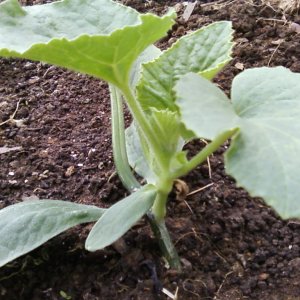
The soil for seedlings is purchased in a store or prepared independently. To do this, mix peat and sand (8: 1), add 1 tbsp. wood ash and sawdust.
The prepared containers are filled with soil mixture by 2/3. The seeds are buried 4-5 cm. The container is covered with foil or glass. After the sprouts appear, the shelter is removed.
Containers with seedlings are transferred to a warm, lighted place. The required air temperature is + 20 ° С ... + 25 ° С during the day and at least + 15 ° С at night. If there is not enough sunlight, the plants are illuminated with a phytolamp.
Important! Correct melon seedlings are healthy shoots with a short, strong stem and 3-4 true leaves.
Seedlings are watered with warm water as the topsoil dries up. A week before transplanting to a permanent place, top dressing is made from 1 liter of water, 1.5 g of ammonium sulfate, 1 g of superphosphate and 1 g of potassium salt.
In warm weather, the seedlings are taken outside for hardening, gradually increasing the duration of the plants' stay in the fresh air. On the last day before disembarking, they are left outside for the whole day.
Ready seedlings are transplanted to a permanent place 30–35 days after sowing. A longer development of plants at home leads to their overgrowth and weakening.
Planting and leaving
Before planting seedlings, the soil temperature is checked, it must be at least + 15 ° C. Usually in Siberia, the land warms up enough in early June.
Plants are planted according to the scheme 70 × 70 cm in pre-prepared and moistened wells. Peat pots are tightly covered with soil and watered. The root collar is left flush with the soil surface. The first 2-3 days the seedlings are protected from the sun with a covering material.
Row spacings are loosened as a crust forms. After the appearance of lateral lashes, the bushes are spud.
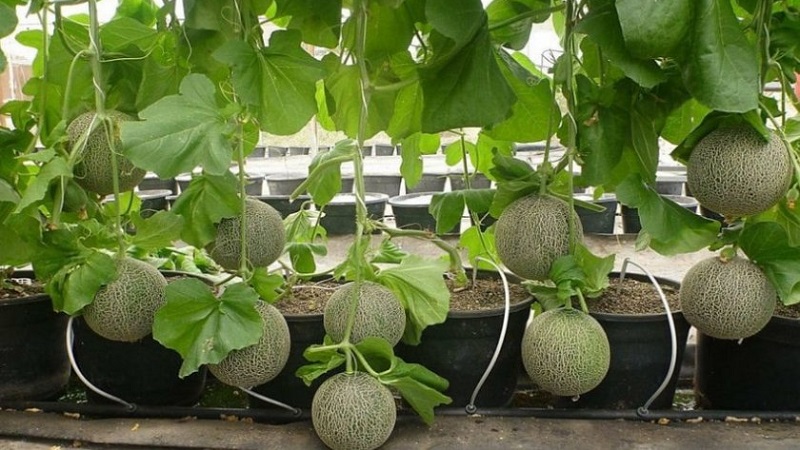
Watering
Moisten the bushes with warm, settled water. For 1 plant use 5-7 liters of liquid.
Important! The ingress of moisture on the root collar and foliage provokes the development of fungal diseases. Therefore, water is poured under the root or at a distance of 3-5 cm from the stem.
The watering regime for melon beds depends on the stage of development of the bushes. After picking, seedlings in dry weather are watered every day in small quantities. When the plants take root, the frequency of irrigation is increased up to 1-2 times a week. When the fruits ripen, watering is reduced to 2 times a month.
Top dressing
For the first time, melon seedlings are fertilized 2 weeks after transplanting to a permanent place.To do this, use a solution of mullein (1:10) or ammonium nitrate (20 g per 10 l of water).
Subsequent dressings are applied at intervals of 2 weeks. A solution of 50 g of superphosphate, 30 g of potassium salt and 30 g of ammonium sulfate per 10 l of water is used.
Ready complex fertilizers are used in accordance with the manufacturer's recommendations. They are brought in only after abundant watering (1–1.5 liters per bush).
In order for the fruits to receive more nutrients, the bushes are formed. This accelerates the ripening of the pumpkins, increases their sweetness and quality.
Protection against diseases and pests
Melons and gourds are susceptible to fungal infections. The development of diseases is promoted by low temperatures, high humidity of air and soil, insufficient heat and sun rays. This provokes the appearance of putrefactive processes on the leaves and fruits.
When caring for plantings, some rules are observed:
- when watering, avoid getting water on the leaves and whips;
- moisturize the bushes moderately, avoiding excess liquid;
- when diving, maintain a sufficient distance between the bushes;
- plantings are periodically thinned out, excess lashes and leaves are removed;
- observe the rules of crop rotation.
In addition to diseases, the melon is attacked by insect pests. The main preventive measure against them is seed dressing in disinfecting solutions (manganese, copper sulphate, "Fundazole" and other similar means).
Harvesting
Depending on the variety, the fruits begin to sing by the end of July. To determine the ripeness of a melon, it is enough to lightly press the peel - in a ripe fruit, it will slightly squeeze. Melons are removed from the garden as they ripen.
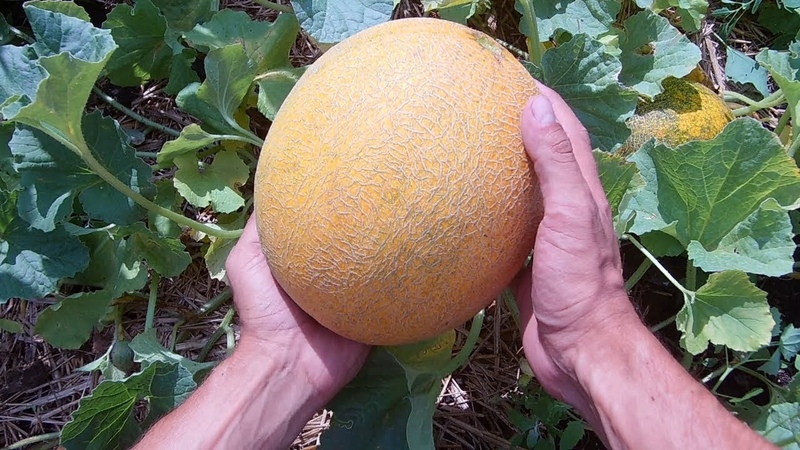 The last harvest is carried out before the onset of cold weather. Fruits that have not had time to ripen are placed on the shelves with the stalk upward or placed in wooden boxes, shifting with straw. In such conditions, the harvest will ripen in 2 weeks.
The last harvest is carried out before the onset of cold weather. Fruits that have not had time to ripen are placed on the shelves with the stalk upward or placed in wooden boxes, shifting with straw. In such conditions, the harvest will ripen in 2 weeks.
When determining the timing of harvesting fruits, they are guided by the peculiarities of the weather. If it's dry and warm outside, you can take your time with cleaning. With prolonged rains and a cold snap, melons are removed before the onset of technical ripeness.
Melon cultivation in Siberia in warm beds
This method of cultivation has long been used by Siberians for growing cucumbers in the open field. It is also suitable for melons.
The preparation of a warm bed begins in the fall. The process consists of sequential stages:
- First, mark the site with a rope. The topsoil is removed.
- Build a box of boards or plywood. The walls should rise about 20 cm above the ground.
- The bottom of the pit is laid out with chopped branches, grass, tree bark, and plant residues.
- Pour half of the excavated earth on top.
- In the spring, horse manure mixed with straw (about 10 cm) is laid out.
- The top of the bed is covered with the remaining soil.
After completion of construction, the bed is spilled with hot water and covered with a dark film, the ends of which are pressed to the ground.
Inside the building, manure with straw overheats and releases heat. After a week, the warm bed will be ready for transplanting seedlings or sowing.
Attention! Manure in a warm bed warms up the soil for 2–3 weeks. Therefore, seedlings are planted on such a bed earlier than on an ordinary one.
If it is impossible to get horse manure, it is replaced with cow or poultry manure, but the heating of the site in this case will take longer, and the period of heat release will be reduced.
Tips from experienced gardeners
For beginner gardeners, advice from experienced farmers will help to harvest a good harvest of melon fruits:
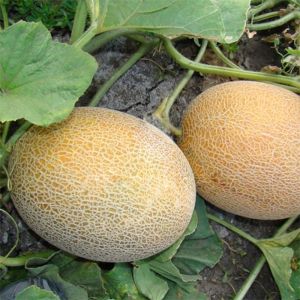
- grow melons in warm beds - so the bushes will be stronger, and the harvest will ripen earlier;
- pinch the bushes in a timely manner - this will accelerate the ripening of the fruits;
- while pinching, do not spare extra lashes - in a short summer, all formed melons will not have time to ripen, and the fruits will grow small and savory;
- avoid thickening of plantings, bushes need a lot of space for growth and development;
- during the ripening period, place boards or other dry material under the fruits to prevent spoilage and rotting of the crop.
Read also:
Is it possible to eat a melon with cholecystitis and gallstone disease?
Conclusion
Growing a thermophilic beauty melon in the harsh Siberian climate is not an easy task. To cope with it will help the choice of a suitable variety, the construction of warm beds and proper care of the bushes. Compliance with the recommendations will allow you to harvest a rich harvest of sweet and healthy fruits, even in adverse weather conditions.